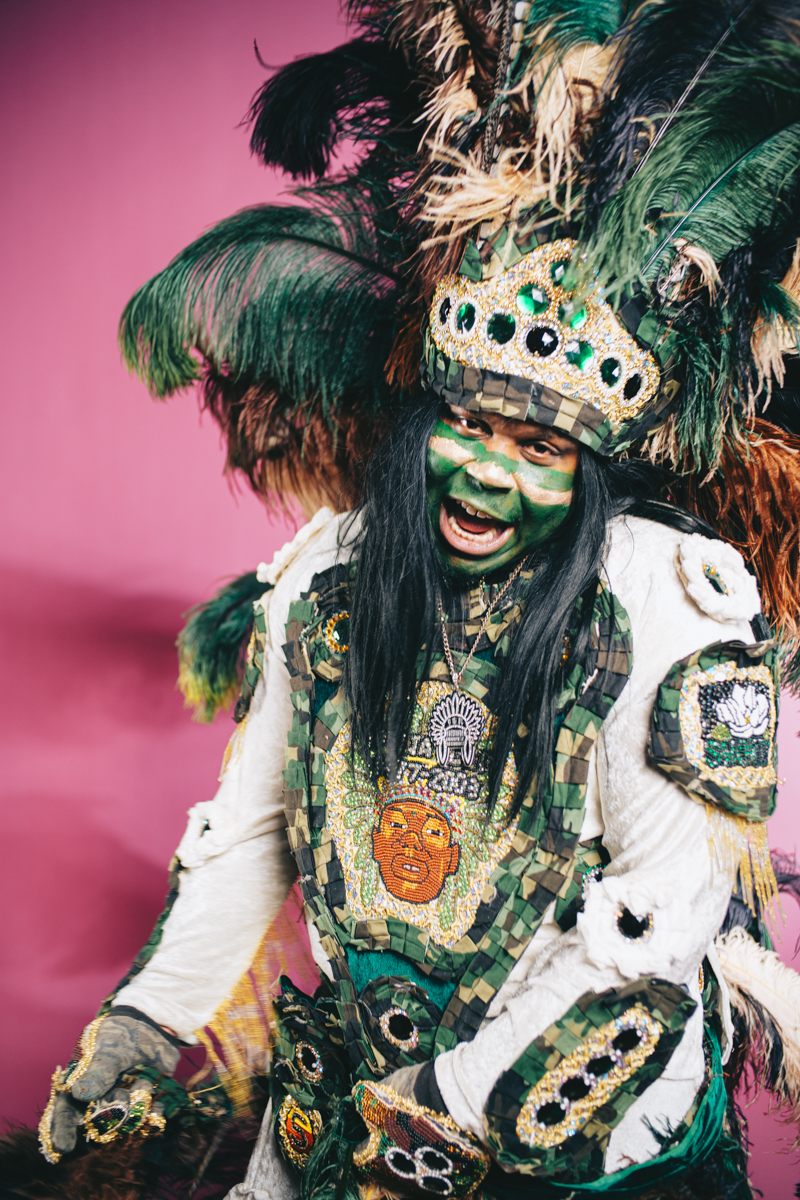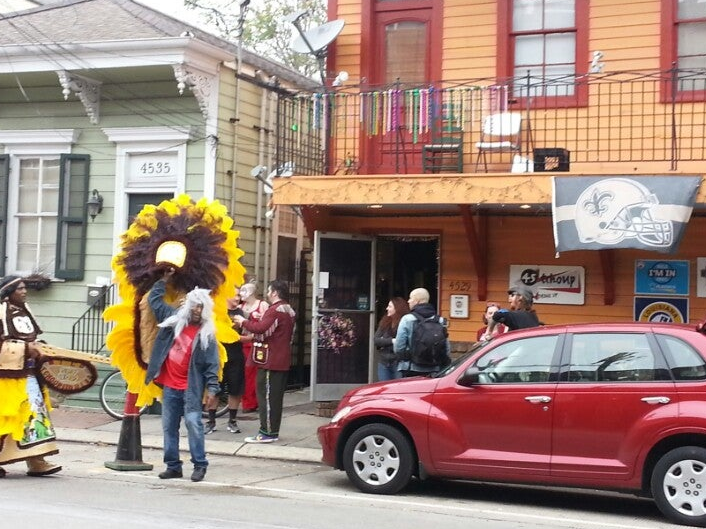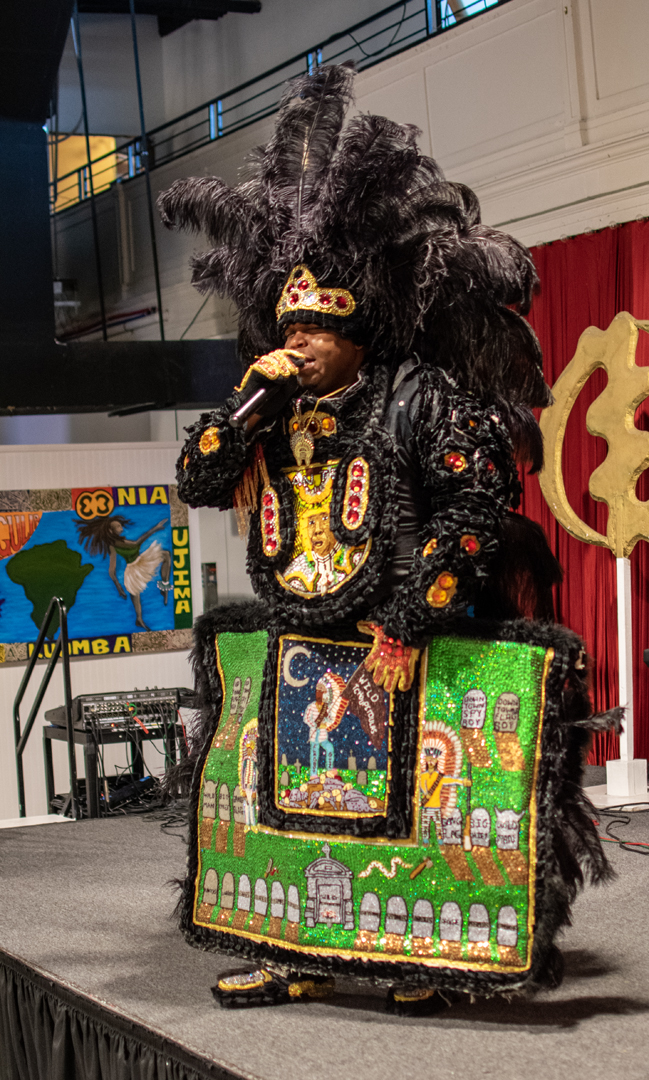Confederate flags, old plantations, pirogue boats and shuttle busses inspired Flagboy Giz, the hip-hop vlogger/activist turned Wild Tchoupitoulas Mardi Gras Indian, to make one of the most important artistic expressions of his career. And it all started with his swamp tours on the Northshore in late 2019.
Giz would lead culture tours there, though he admits he didn’t know what he was sometimes doing, especially on the kayak tours. It wasn’t uncommon for tourists to want to get closer and snap photos while Giz paddled back a little bit and let them get close.
“People could have died,” he said, explaining how most of the ‘gators in the area associated humans with food and had learned not to be afraid of people a long time ago. Giz often opted to drive the tour van instead. There he could sew. Interestingly, all the Trump 2020 banners heavily influenced his beadwork.
“You don’t always want to sew war scenes with Indians killing southern Whites from the 1800s,” Giz explained, “But the feeling you got just being in the swamp, sitting there alone while you were surrounded by all this, I couldn’t sew anything too light.”
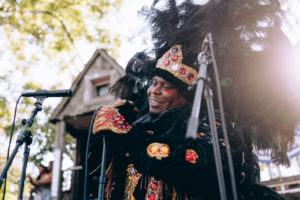
Photo by Noé Cugny
The result would be Flagboy Giz’s iconic red, white and blue suit that told the story of Robert Charles, a Black man who resisted racial profiling by police in 1900 that led to a shootout. Charles shot and killed two White police officers in the encounter, sparking race riots that killed 28 people, including Charles, and burned down important Black properties, including the Thomy Lafon School.
Giz would later burn that suit but featured it on the cover of his sophomore album, I Got Indian In My Family. Using American flags and other scavenged materials in the swamp, Giz built his masterpiece.
“It was a piece of performance art,” Giz explained, “They’d be hanging Confederate flags and American flags on their house and [I’d] go run up and steal the American flag, then run it through a sewing machine to make ruffles out of it and then make it into a suit about a Black man who resisted.”
Musical Roots
We were outside Shakespeare Park, a.k.a. A.L. Davis Park, where Giz recalled these stories while showing me locations important to him. His real name is Aaron Hartley, 35 years of age, and in the last two years, Giz has become a force in the Mardi Gras Indian music world and beyond, landing deals with Mannie Fresh and making a headdress for production designer Hannah Beachler of the Black Panther movies. However, he says he owes his musical journey to hip-hop.
“I got my own field of study. I was a big fan of Cash Money, the Hot Boyz,” Giz said, “I wanted to be a Hot Boy so bad. One Christmas, my momma asked what kind of outfit I want. I said, ‘Tees, Beaus and Rees.’ She was like, ‘What?’ And I said, ‘A white T-Shirt, with some Girbauds and some Reeboks.’”
He started out making beats in high school. Then in college at the University of New Orleans, he joined the 2-Cent Entertainment Collective, making videos that parodied rap artists pretending to be Rick Ross or a “fat Lil Wayne.” Hurricane Katrina hit while he was still in school. While he was living in Baton Rouge post-Katrina, producers from the show MTV’s True Life found Giz and went with him to survey the damage in an episode called “I’m Returning to the Gulf Coast” (8-29-2006). While doing that, Giz saw firsthand the potential of video and it inspired him to pursue media skills with the 2-Cent Collective.
“From that process, we all developed skills to create our own media, whether it was like guerilla filming on sets with not a lot of money, the actual editing process, or the hands-on learning on how to frame a shot,” Giz explained, “And being on MTV True Life, seeing them come out with those boom mics, wearing those White Balances, micing me up right, getting permits to go into those locations and film prepared me for when the pandemic hit.”
After the COVID-19 pandemic started, Giz lost work with the touring company and instead started documenting the Mardi Gras Indian world he had joined years prior. He wanted to help people photograph and capture themselves on video. Giz’s “We Outside” remix music video series realized the power of the camera, where he featured 36 Black New Orleans artists performing their verses on his song with him suited up. But the camera work was just half the story.
“I wanted to make a new era of fans for Mardi Gras Indians,” Giz explained, “Music is powerful. The call-and-response chants, that’s powerful. When you saying something and a whole group is chanting back to you and they all feel something, it’s spiritual.
Mardi Gras Indian Music
Music has always been a part of Black masking Indian culture, whether call-and-response style chants or simple percussion from tambourines and bells. However, it wouldn’t leak into the mainstream until the 1950s, ’60s and ’70s when New Orleans funk and R&B legends like Sugar Boy Crawford, Professor Longhair, and Dr. John started borrowing from the tradition.
At around the same time, Allen Toussaint and the Neville Brothers brought the music into the studio with their uncle George “Big Chief Jolly” Landry and the Wild Tchoupitoulas. Now, Mardi Gras Indian music is almost synonymous with funk and R&B, thanks to that legacy. In recent decades the music has evolved further, with some groups continuing the funk sounds of the ’70s.
“I kept those drums, those tambourines in there and then some 808s [a type of electronic percussion sample] and do some beats you’re not used to hearing, but it’s still call-and-response, it might even be the same chants, but this right here is ‘Turn that up! Turn that up!’,” Giz said.
According to Giz, fusing hip-hop with Mardi Gras Indian music has succinctly captured New Orleans Black culture.
“These rappers rap about gangsta stuff that they don’t really do,” Giz said. “Sometimes when you put these Indian suits on and the spirit gets into you, you really do some gangsta shit. You really run up on dudes telling them some crazy shit. You really pushing dudes in the streets. You really yanking wigs, yanking people’s flags out their hands. So, if you really think about what hip-hop is, gloating about the gangsta shit you do, it makes me think, ‘How can I do that in Mardi Gras Indian music?’”
As we stood outside the Mardi Gras Indian holy ground that is Shakespeare Park on Lasalle Street in Central City, Giz recalled many gangsta memories.
“One time I walked into this park. My Big Chief had just cursed me out because I was too nice to somebody,” Giz recalled, “He was like, ‘Man, this St. Joseph’s night. Ya ain’t shit letting people get past you…”. Man, I think my girl was there. I was feeling a way like he didn’t have to talk to me like that.”
So Giz, masking as Flagboy and Spyboy that year, marched off into Shakesphere Park upset, “freshly cursed out” and “hot.”
In the heat of the moment, Giz walked up behind an Indian, yanked his wig off and said, “You dead!”
The Indian then pointed his machete at Giz and told him, “You give me that back or I’m gonna stab you out here.”
“And he never got it back because 20 people done hopped in front of him,” Giz said, describing the scene.
Giz took his wig, walked through the park and said, “Y’all wanna see a dead Indian, follow me.”
A crowd started to form as he carried the wig, wearing his black suit with tombstones all over it. He was looking for blood, trash-talking every Indian he met, “Man, you ain’t shit, get out my way. Tell your Chief to bring his ass up here.”
Calling out Chiefs was something his own Chief told him never to do, but he had “just cursed me out in the street, so whatever man, fuck you.”
As Giz was popping off and stirring up the park, a police officer stopped him.
“Hey big buddy, you gotta put the machete up,” the officer told Giz.
“I think he thought I’d ruin the peaceful image of what [Mardi Gras Indians] had evolved into and I was like, ‘Bro, I’m not about to hurt nobody with this. I can hurt your feelings without it, this just for the look.’”
The officer double-downed and said, “You’re gonna put that up or else you’re going to jail.”
“You tell my Chief to tell me to put it up” Giz responded.
To which the officer obliged and told on Giz to his Chief. After his fiery rampage, he had been sufficiently doused by a cop. He walked out of the park onto Washington Avenue where “a baby ran up on me with a real machete, 5-years old.”
“I done have to put up my shit up because the police got in the way and I got a real damn weapon being swung at me by a child,” Giz said, laughing.
Wild Tchoupitoulas
It’s these lived experiences that Giz infuses into his music to make not only authentic hip-hop but also to honor the culture of the masking Indians. Giz includes everything in his music and videos, from the weed smoke to the motorcycles, to the booty cheeks hanging out at the second line, but in respect for the culture, he makes it a point not to curse in his music.
“This stuff can be shared to the next generation,” Giz explained, “I always thought it was the coolest day of school when the Mardi Gras Indians came. We got out of class and seeing how fire their suits was like ‘How do they sew everything every year?’ So, I remember saying that from the time I was a little kid to now, if I’m gonna make music for the next generation, I want to them to know that this culture is thought of as sacred.”
Even the elders will listen to his music with respect says Giz.
“Even though they’re too old to say that it’s the music of their generation, they love what I’m doing and how I’m doing it,” Giz said, “And their kids love it. They’ll be playing Mardi Gras Indian music and they put me on and it’s like a break from what they’ve been hearing.”
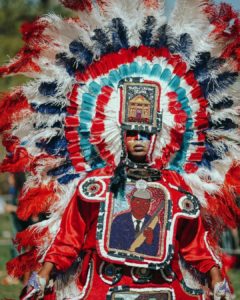
photo courtesy of Flagboy Giz, Facebook
Flagboy Giz first joined the Wild Tchoupitoulas in 2015. He was invited to Super Sunday downtown after approaching the Chief, Rodrick Sylvas, about joining the tribe. His Chief was working as a cab driver then and laid the pieces of his suit on top of his cab as he was waiting on Giz.
Seeing the suit laid out like that intimidated Giz at first but eventually, he thought to himself that he could make a suit of his own. His work with the 2-Cent Collective was slowing down and he had more time on his hands than ever. So, after seeing the Chief’s handiwork, he decided to make his own.
“The hardest part was finding the beads,” Giz said, “It was a lot of trial and error.”
His Chief told him everything he’d need but the rest was up to him—canvas, beads, feathers and thread (the best thread according to Giz, floss). He’d find the materials he’d need and start experimenting, looking towards midwestern Native American beadwork for inspiration. According to tradition, every Indian’s first and last suit is supposed to be white, but due to an ordering error at his shop, Giz had to use all pink feathers instead.
“My Big Chief was like, ‘You gotta make it work,’” Giz said, “You gotta be led by the right Chief. Some tribes will say everybody’s gotta wear lime-green this year. My Chief is like, ‘Look you put your money and time into this, you wear whatever you wanna wear.’”
Giz showed me a photograph of him in his first suit that hangs inside the bar and home base of the Wild Tchoupitoulas, Tchoup 45 on Tchoupitoulas Street, not far from Tipitina’s. It’s here that Giz and the tribe set up every Mardi Gras morning before they make their march across the city. Each year, Giz arrives no later than 5:30 a.m. to lay out his gear, paints his face, gets breakfast at Rouses across the street and suits up to join his Chief once he comes drumming down the street.
Giz remembers the first morning he met the tribe there.
“When I pulled up, I saw one of the Indians from my tribe and I thought, ‘I got on more than that, I’m ready,” Giz recalled.
He learned the rules of Mardi Gras Indians out on the streets that day. One of the most important was not dancing with anybody unless they shake your hand first. Giz didn’t listen.
“The very first Indian I met, I almost had to beg in the street for my stuff back,” Giz explained the fallout of the mistake, “I started dancing with him and the dude tried to yank my flag out my hand. I was strong-armed with it, so he didn’t get it, but I almost died in the ritual in the very first meeting.”
Giz’s high school football days came in handy for the rest of Mardi Gras that day, but he wasn’t just brawn. Even the Big Chief of the Golden Eagles and Mardi Gras Indian music legend Monk Boudreaux said he was “pretty.”
“That was definitely the highlight of my first Mardi Gras,” said Giz, “Just knowing him from all the Jazz Fest posters and then to meet Monk Boudreaux… he told me, ‘This your first year, you pretty too,’ and that was it, man. What the fuck all those other Indians talking about. I’d be like, ‘Whatchu talkin about, Monk Boudreaux say I’m pretty!’”
Then Giz’s first St. Joseph’s night came, which made him realize he had the spirit.
“It’s almost like when you were in school and you got nice shoes on and somebody talks about you. ‘But your shoes ugly, wrinkle-ass shoes.’ It turned on instantly,” Giz said.
Not unlike dissing Indians over the size of their beads, Giz saw other Indians try to rap about the culture and knew that he could do it better. Using old beats from his 2-Cent Collective days, Giz started developing tracks. Every time he wore a suit, it gave him more content from which to draw his bars and to increase respect for him.
“It got to the point where people would shake my hand and ask to take a photo with me,” Giz said, “I’m sitting in the middle of a meeting, posing like, ‘Man, if you don’t tell me I’m ugly. Tell me I’m shitty. Tell me I could’ve sewed better. Tell me my beads too big. Tell me something.’”
Giz always had trash to serve other Indians, even in his music. His most iconic disses target the folks he calls U-Haul Indians, masking Indians who, rather than walk across the city in their suits as is traditional, rent a U-Haul and drive out to the center of town before suiting up.
“Y’all not really doing the ritual of Mardi Gras morning. I’m saying f*** all the police, skipping all the barricades and runnin’ over people. Y’all aren’t doing all that. Y’all chanting in the U-Haul? Y’all singing, ‘My Big Chief got a golden crown,’ in the U-Haul??”
For the Wild Tchoupitoulas, it’s a point of pride that they walk from the Tchoup 45 to as far as St. Augustine Catholic Church and back. In fact, the route it’s so crucial that the artistry in their suit-making takes the long trek into account. Giz once made a crown so heavy that he couldn’t look down for two hours after wearing it. The headdress was around five feet tall and weighed approximately 15 pounds, which Giz thought he could handle like football pads and helmet. Since then, he’s made his headpieces lighter or with more support.
Doing the Culture Right
Although criticism about beads and U-Hauls might seem petty, issues run deep into preserving the larger culture of Black masking Indians. A common trope found in Indian culture is the “photo poacher,” an opportunistic kind of photographer who profits off images of the Indians without giving royalties, much less credit to the Indian.
He also took me to the Mardi Gras Indian Council building, across the street from Shakespeare Park, where a council member gave Giz a print a photographer snapped of him.
“That’s how [photographers] pay you, with a print. ‘There ya go, we’ll go sell you around the world. Here’s the payment in case you forgot what you look like,’” Giz scoffed.
It’s a change he wants to see in the culture and there has been some progress on deeming Indian suit designs as copyrightable. Giz’s history with making online videos taught him the value of images. Now he promotes the message to Indians, encouraging them to hire their own photographers, register their suits for art patents and even help tribes write grants to help fund their defense. Even in building his suits, Giz plans a defense creating feather wings like on his camo suit to help him “close-up” and cover the elaborate beadwork he hides on his chest.
“A lot of Indians aren’t doing this for profit,” Giz said, “They’re doing it because they appreciate it but if everyone else is going to be profiting off you, make sure you’re not making the least amount of money.”
The last spot Giz showed me was the back house that’s detached from his home in Gentilly. He mostly uses it for laundry, as old clothes and random objects clutter the space like an empty terrarium for his departed Pacman frog. But also in the cramped space, he kept a computer desk where he produces beats, boxes full of beads, feathers and ruffles, and the stand displaying his black suit. He criticized the suit, saying how it’s all crooked, how this is falling apart, and how that needs to be redone.
The chaos and disorder he keeps hidden in the laundry room like hundreds of tiny beads spilled deep into the carpet—it’s the cost of looking so pretty on Mardi Gras. It’s late nights sewing together elaborate bead patterns and then producing beats to feature on the next project. It’s the cost of doing the culture right, taking it from a creative spirit in the swamp to the streets.

